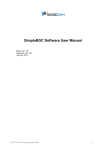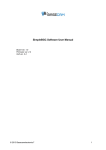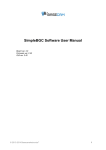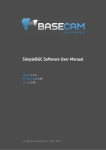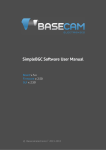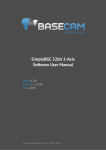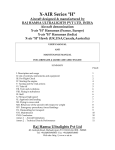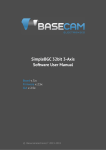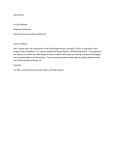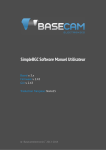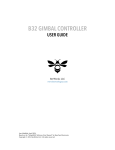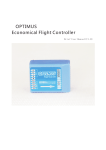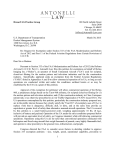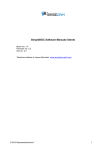Download SimpleBGC Software User Manual
Transcript
SimpleBGC Software User Manual Board ver. 3.0 Firmware ver. 2.4 GUI ver. 2.4 © 2013-2014 Basecamelectronics® 1 Connection to PC To connect board to your PC, you need a miniUSB cable. First time a USB cable is plugged, you need to install the appropriate software driver. If your PC does not install the driver automatically, install one manually from this link: http://www.silabs.com/products/mcu/pages/usbtouartbridgevcpdrivers.aspx. After you install the driver and connecting the board, a new virtual COM port will be created. You need to choose this COM port in the SimleBGC software (GUI) to initiate the connection. It is safe to connect USB and main power (battery) simultaneously. But be very careful to not reverse the polarity of the main battery, because in this case it will burn out controller and may damage your PC! There is also a possibility to use Bluetooh–To-Serial adapter (HC-05, HC-06, Sparkfun BlueSMiRF, and comparable) to connect to the GUI and tune the board remotely. There is a special connector on the board that matches the same one on the BT module. It is marked as UART and contains pins: 5V, GND, RX, TX. You can solder BT module over it or use extender Male-Male 4pin cable. IMPORTANT NOTE: Bluetooth module must be configured at 115200 baud rate and Even parity (generally its not set by default!). Refer your module's user manual to find out how to configure bluetooth. With these settings, you will be able connect to the GUI and even to upgrade firmware remotely. Running application Follow these steps to connect your main controller board to the GUI software: Connect the mini-USB cable Start the GUI, select correct COM-port from the list, and click "Connect". After the connection is established, all board settings and profiles will be loaded into the GUI. You can re-load the current board parameters anytime by clicking the "READ" button. After adjusting parameters in the GUI you should write them to the controller board by clicking the "WRITE" button. Only the current profile parameters will be saved to the board. To return to the default settings push the "RESET TO DEFAULTS" button. To choose a different profile (with different settings) select it from the list of profiles (located in the upper right corner of the GUI window). You can store different settings as three different profiles onto the controller board. You can switch profiles saved on the board by choosing the profile in the GUI or by pressing the MENU button on the controller board. Remember that some settings are common for all profiles and can not be saved on a per-profile basis. Parameters such as sensor orientation, hardware configuration, RC inputs, and motors outs are the same across all profiles. The GUI starts in the English version of the user interface. To change the interface language, choose one in the 'language' menu and restart the program. © 2013-2014 Basecamelectronics® 2 GUI Blocks The GUI contains different functional blocks: 1. Configuration block in the central part of the window, organized by ‘tab’: Basic – Basic gimbal stabilization settings. Adjusting these settings is usually adequate to achieve good camera stabilization. Advanced — More precise tuning options. RC Settings – settings to control the gimbal roll/pitch/yaw orientation with RC inputs. Service – Specify the behavior of the MENU button (located on the controller board or mounted externally) and tune the battery monitoring service. Follow Mode – settings related to special mode of the camera control. Real-time Data — real-time sensor data monitoring. This screen is extremely helpful in tuning your gimbal performance. Firmware Update — Firmware and GUI software versions and update options. Firmware Upgrade – lets you to check the fresh version of firmware and upgrade if necessary. 2. Connection — COM-port selection and connection status. 3. Profile — Profile selection, loading, re-naming, and saving. 4. Control Panel — graphic visualization of gimbal orientation angles in three axes. Black arrows are displaying the angles, blue arrows are a 10x time magnification to provide higher precision. Red marks show target angles that gimbal should keep. Thin blue lines shows the maximum (peak) deflection from the central, neutral point. © 2013-2014 Basecamelectronics® 3 Blue digits show peak deflection amplitude. Using these numbers, stabilization quality can be estimated. Vertical red bars to the right of the scales show actual power level, from 0 to 100%. 5. READ, WRITE, RESET TO DEFAULTS buttons are used to transfer setting from/to board. 6. MOTORS ON/OFF button is used to toggle motors state. 7. At the bottom of the screen, tips, status or error messages (in red color) are displayed . Overall cycle time and I2C error count is also displayed. 8. Battery voltage indicator with warning sector. Basic Settings Note: Before tuning your controller, install the camera into the gimbal firmly and ensure your gimbal’s center of gravity is leveled as much as possible. P,I,D – PID regulation parameters for all axes. . ◦ P – describes the power of disturbance response. Higher values means a stronger response reaction to external disturbance. Raise this value until the stabilization quality of fast disturbances will be adequate. If the “P” value is too high, oscillations of the axis will start to be present. These oscillations will get worse if there are vibrations that reach the IMU sensor board. If oscillations occur, raise the “D” parameter by 1 or 2 units, and then try to raise the “P" value again. ◦ D – The “D” value reduces the reaction speed. This value helps to remove low-frequency oscillations. A “D” value that is too high can cause high-frequency oscillations, particularly, when the IMU sensor is exposed to vibrations. ◦ I – The “I” value changes the speed at which the gimbal moves to incoming RC commands and to move the gimbal back to neutral. Low values result in a slow and smooth reaction to RC commands and to getting back to neutral. Increase this value to speed up the movement Limit Accelerations - this option lets to limit angular accelerations in case of hard RC or Serial control (useful to prevents jerks or skipped steps, smoother camera control, less impact on the multirotor's frame). The less is value, the smoother is camera rotation under control. POWER – maximum voltage supplied to the motors (0 - 255, where 255 means full battery voltage). Choose this parameter according to your motor characteristics. Basic tuning: ◦ Motors should not get too hot! Motor temperatures of over 80С will cause permanent damage to motor magnets. ◦ A Power value that is too low will not provide enough force for the motor to move the gimbal and stabilize the camera adequately. A low power value will be most noticeable in windy conditions, when the gimbal is not well balanced, or if the gimbal suffers from mechanical friction. Slowly lower the Power parameter to find its optimal value. Find the lowest value that still provides good stabilization and adequate holding torque. ◦ Raising the power equals raising the “P” value of PID settings. If you raise the POWER value, you should re-tune your PID values as well. “+” - Additional power that will be add to the main power in case of big error (caused by missed steps). It helps to return camera to the normal position. If main power + additional power is greater than 255, the result is limited to 255. INVERT – reverse motor rotation direction. It's extremely important to choose the correct motor rotation direction to not damage your gimbal. To determine the correct direction, set the P, I, and D values to 0 and the POWER values to 80 (or higher if your motors don’t produce enough force to hold/move the camera). Level the camera tray horizontally and click the AUTO button in the "Motor configuration" settings. The gimbal will make small movement to determine correct © 2013-2014 Basecamelectronics® 4 motor rotation direction. Wait for the calibration procedure to complete. Then, re-set your PID values and tune your Power values. NUM.POLES – Number of motor poles. This value needs to be equal to the number of magnets in your motor’s bell. During the “auto” calibration process described above, this value is automatically detected. However, this value is sometimes not correctly determined during the “auto” calibration process and will need to be verified and possibly corrected manually. Most brushless gimbal motors are built with 14 poles (or magnets) and utilize a DLRK winding scheme. Count your motor magnets and enter this value if the value is not correct in the GUI. External FC Gain – Gain value for matching the gimbal data from your flight controller (optional). For better stabilization and utilization of some additional features, the knowledge about the frame inclination angles is required. SimpleBGC IMU doesn't provide such information. Most of FC have servo outs for connecting gimbals. This outs should be connected to SimpleBGC controller through EXT_ROLL and EXT_PITCH inputs. ◦ Activate gimbal outs in FC and set range limits for angles you generally fly (for example ,+30 degrees of frame inclination should equals full servo range about 1000-2000). ◦ Deactivate all filters and smoothing of FC gimbal settings (if present). ◦ In the RC-settings tab, make sure that inputs EXT_ROLL, EXT_PITCH doesn't used to control gimbal. (i.e. are not chosen as source for any other RC control task). ◦ In REALTIME DATA tab, check availability of EXT_FC_ROLL, EXT_FC_PITCH signals, and make sure they are split to axes correctly. (Frame roll angle tilting should cause EXT_FC_ROLL change in approximately 900..2100 range. The same is for pitch.) ◦ Connect power supply, and setup stabilization as described above (tune POWER, INVERT, PID) ◦ Push AUTO button in FLIGHT CONTROL GAIN group, and smoothly incline copter frame to different directions by all axes for 10-30 seconds. ◦ Push AUTO button again to complete calibration. (Calibration will stop automatically after some time too). New gains will be written into EEPROM and shown in the GUI. NOTE : You may skip this step and leave zero values at initial setup. Sensor — Specify your IMU sensor board’s orientation and position on the gimbal . For a standard IMU sensor installation, look at the gimbal from behind just like the camera will view out from the gimbal. Viewing the gimbal in this way, the UP and Right direction will match the Z and X axis. You can place the IMU sensor in any direction, keeping its sides always parallel to the motor axis (be very accurate here, it is a very important to precisely align the sensor and mount it firmly). Configure your IMU orientation in the GUI. The correct configuration should result in the following: ▪ Camera pitches forward – the PITCH arrow spins clockwise in the GUI. ▪ Camera rolls right - ROLL arrow spins clockwise in the GUI. PITCH ▪ Camera yaws clockwise - YAW arrow spins clockwise. ✔ ROLL © 2013-2014 Basecamelectronics® 5 ◦ Skip Gyro calibration at startup - With this option, the board starts working immediately after powering it on, using the saved calibration data from last gyroscope calibration call. However, stored calibration data may become inaccurate over time or during temperature changes. We recommend you to re-calibrate your gyro from time to time to ensure the best performance. Second IMU sensor There is an option to install the second IMU sensor on the gimbal's frame. The advantage is more precise stabilization (you may use lower PID's to get the same quality) and knowing of frame tilting, that greatly helps for 3-axis system to extend the range of working angles. Second IMU should be connected to the same I2C bus as main (in parallel). Sensors should have different I2C-address (Main IMU – 0x68, Frame IMU – 0x69). On the Basecam IMU, address 0x69 may be set by cutting the ADDR bridge, located on the back side of the sensor: Mounting the Frame IMU There are two options where to place the second IMU: below YAW motor and above it. In case of 2axis stabilization, there is only one option – above ROLL motor. Frame IMU: above YAW YAW MOTOR below YAW (above ROLL) ROLL MOTOR PITCH MOTOR Camera IMU If the sensor is placed above YAW motor, it helps to stabilize ROLL, PITCH and YAW motors. But the system becomes less stable during long work (because the frame heading, estimated from the second IMU, may drift with time and auto-correction may not work in all cases). If the sensor is placed below YAW motor, it does not help YAW axis stabilization, but works more reliable. Like the main (camera) IMU, the frame IMU may be mounted in any orientation, keeping its axis parallel with motor's axis. © 2013-2014 Basecamelectronics® 6 Configuring the frame IMU To configure the frame IMU, first of all set its location in the “Advanced” tab, “Sensor” area. Write settings to the board and go to the “Basic” tab. Press the button “Frame IMU”: If the second IMU is connected properly, this button becomes active. It means that all IMU settings now affect on the frame IMU. Change sensor orientation (axis TOP, RIGHT) and write setting to the board, if necessary (board will be restarted). After restart, calibrate the accelerometer and gyroscope like you did it for the main IMU. For the accelerometer, you can do simple calibration or extended 6-point calibration. You may notice that right panels with arrows are displaying now angles not for the main, but for the frame IMU. Also, in the “Realtime Data” tab, accelerometer's and gyroscope's data go for the frame IMU. It helps to properly configure an orientation of the sensor and check its calibration. RC Settings tab RC Input Mapping – here you can assign hardware RC inputs to virtual control channels. There are 4 hardware inputs provided on the board for RC Radio control connections, which you can assign to control any of three channels, one for each axes, and one command channel. If control for an axis is not needed, leave the option at "no input". RC_ROLL pin mode – allows to configure several formats of incoming signal for RC_ROLL pin: ◦ Normal – incoming signal is in the PWM format, that most RC-receivers generally outputs ◦ Sum-PPM - some receivers may have this signal output. It is a PWM format modification, in which every channel transmits sequentially through one cable. In this case you do not need to connect other channels (read your receiver's user manual to check if it has SumPPM out). ◦ Futaba s-bus – receivers made by Futaba may transmit data in special digital format, up to 16 channels by one wire. Connect it to RC_ROLL pin. ◦ Spektrum – another digital multi-channel protocol, that is used to communicate Spektrum's satellite modules with the main module, and in its clones. Because there are many modifications of this protocol, it may not work as expected in the first versions of SimpleBGC firmware (but we will work on correct implementation in next versions). There is a dedicated socket on the board (marked Spektrum) that matches standard connector. You should bind satellite module with the transmitter manually. For each control targets you can choose appropriate hardware input from the drop-down list. ◦ RC_ROLL, RC_PITCH, RC_YAW, FC_ROLL, FC_PITCH – hardware inputs on board that accept signal in the PWM (Pulse Width Modulation) format (excepting RC_ROLL, see above). Most RC receivers output this signal type. ◦ ADC1, ADC2, ADC3 — dedicated analog inputs, marked on the board as A1, A2, A3 and accepts analog signal in range from 0 to +3.3 volts. For example, joystick variable resistor provides such signal. Connect A1..A3 to the center contact of variable resistor, +3.3V and GND to side contacts. See Connection Diagram for more info. ◦ VIRT_CH_XX – In case of RC_ROLL pin mode is set to multi-channel signal format, you can chose one of the virtual channels. Control targets: © 2013-2014 Basecamelectronics® 7 ◦ ROLL, PITCH, YAW - controls the position of the camera ◦ CMD allows to execute some actions. You can configure 2- or 3-position switch on your RC for specified channel, and assign it to CMD channel. Its range is splitted into 3 sections : LOW ,MID ,HIGH. When changing the position of your RC-switch, signal jumps from one section to another, and assigned command is executed. The full list of available commands is described in the section “MENU BUTTON” of this manual. ◦ FC_ROLL, FC_PITCH – is used to mark any of PWM inputs to be a signal from the external flight controller. See “External FC gain” section for details. RC Mix - you can mix 2 inputs together before applying to any of ROLL, PITCH or YAW axis. It lets to control the camera from the 2 sources (joystick and RC for example). You can adjust the proportion of the mix from 0 to 100%. ANGLE MODE — RC stick will control the camera angle directly. The full RC range will cause a camera to go from min to max angles, as specified above. If RC stick doesn't move, camera stands still. The speed of rotation depends on the “SPEED” setting and the acceleration limiter setting. SPEED MODE — RC stick will control the rotation speed. If stick is centered - camera stands still, if stick is deflected, camera starts to rotate, but does not exceed min-max range. Speed is slightly decreased near min-max borders. Speed of rotation is proportional to stick angle and the SPEED setting. RC control inversion is allowed in both of control modes. MIN.ANGLE, MAX.ANGLE – range of the angles controlled from RC or in Follow mode. To inverse the control, set higher value first, and lower value second. For example, if you want to configure a camera to go from leveled position to down position, set 0-90 (or 90-0 to inverse). LPF – Control signal filtering. The higher is value, the smoother is reaction to the stick commands. This filter cuts fast stick movements, but adds some delay. Follow Mode There is a special control mode, when the camera “follows” for a tilting of the outer frame, but eliminates small frame jerking. Several modes of operation are possible: • Disabled – camera is locked to ground and may be rotated only from RC. ◦ Estimate frame angles from motors - it use magnetic field for rough estimation of frame tilting. Helps to increase the range of the frame angles where the gimbal's operation is stable. To proper operation in this mode, it is strictly required to calibrate Offset setting (see below). Like with the Follow mode, its not recommended to use this option in flight, its dedicated for hand-held systems only. NOTE that this option is ignored if you connect second IMU mounted on the frame, because the data from the second IMU is more precise than from motors.) • Follow Flight Controller – camera is controlled from RC together with the mixed signal from an external flight controller (FC). Almost every FC has servo outputs to drive a gimbal. It feeds the information about the frame angles to this outputs, in the PWM format that all servos understand. SimpleBGC can get this information and use it to control a camera. It is necessary to connect and calibrate external flight controller (see EXT.FC GAIN settings). After calibration you can setup the percentage values for ROLL and PITCH axis, so the camera will follow frame inclinations. • Follow PITCH, ROLL – this mode is dedicated to hand-held systems. FC connection is not required. In this mode, the position of the outer frame by PITCH and ROLL is estimated from the motor's magnetic field. This means that if motor skips steps, position will be estimated incorrectly and operator should correct camera by hands, returning it to proper position. You should use this mode carefully for FPV flying, because if the camera misses its initial direction, there is no chance to return it back automatically. © 2013-2014 Basecamelectronics® ROLL axis mode locked to the ground soft transition angle of the camera inclination by PITCH follow frame 8 ◦ Follow ROLL start, deg. - Set the angle (in degrees) of the camera PITCH-ing up or down, where the ROLL axis enters follow mode. Below this angle, ROLL is in lock mode. ◦ Follow ROLL mix, deg. - Set the range (in degrees) of the camera PITCH-ing, where the ROLL axis is gradually switched from the 'lock' mode to 'follow' mode (see picture) Hint: to completely disable follow for ROLL, set these values to (90, 0). To permanently enable follow for ROLL (regardless of the camera PITCH-ing), set values to (0, 0). • Follow YAW – the same as above, except it can be enabled only for YAW axis. For example, you can lock camera by ROLL and PITCH axis by selecting “Disabled” option, but still control camera by YAW by enabling “Follow YAW” option. There are additional settings to tune follow mode: • Dead band, degrees: you can set the range where the rotation of an outer frame does not affect the camera. It helps to skip small jerks when you operate gimbal by hands. • Expo curve: you can specify the strength of the control when outer frame declines from neutral position. For example: when the expo curve is enabled (i.e. is not flat), small or medium declination of an outer frame will cause very fine control even if I-term is configured high. But the strength of control exponentially grows when angles of declination becomes close to 60 degrees. It gives a big freedom in camera operation: from fine and smooth control to very fast movements. • OFFSET: it is a very important to properly configure the initial position of the motor's magnetic poles, because all further calculations use this information. For YAW axis it allows to fine adjust a camera heading relative to a frame heading. For PITCH and ROLL axis there is an option to calibrate offset automatically. To do this, power on system, hold frame leveled, and press AUTO button. Don't forget to write setting when finished. If the camera after power on is not leveled, you need to adjust the offset setting. ✔ • SPEED - adjust the speed of the camera rotation in the follow mode. Don't set big values that motors can not handle (if motor does not produce enough torque, it will skip steps and synchronization will be broken). In this case, acceleration limiter may help to have big speed but do not miss steps. Operation in the Follow Mode At system startup in the follow mode, keep the frame horizontally and manually adjust the camera to the horizontal position, and adjust it's heading. Camera easily "jumps" between the magnetic poles. Rotate the camera by hands to desired horizontal position, it will stick to the nearest magnetic pole. © 2013-2014 Basecamelectronics® 9 Gently rotate and tilt the frame. Turns within ± 45º will control the speed of the camera from 0 to 100%. Camera rotates in accordance with the SPEED settings until it's angles are not equal the frame's angles, or until given restrictions will be achieved. If the camera moves unpredictably, perhaps its the wrong direction of rotation of the motors and you need to change the Reverse flag in the 'Basic' tab . To achieve the smooth motion, increase the LPF parameter (in the 'RC' tab), increase Expo curve, and decrease the SPEED and the Acceleration limits. For more dynamic control, change these settings in the opposite direction. In case of failure of stabilization due to external disturbances, the camera can completely lose synchronization with the frame . In this case, it is necessary to return it to the proper position by hands. IT IS VERY IMPORTANT to keep the frame horizontally, because at this point the frame's zero angles are calibrated. You can switch between modes on-the-fly by activating different profiles. Camera will keep their position between modes. Advanced tab AHRS - options influencing on camera angle determination accuracy. ◦ Gyro trust – The higher is value, the more trust to the gyro data compared with the accelerometer data when estimating angles. It can reduce errors caused by accelerations during moving, but also decreases gyro drift compensation, resulting in horizon drift over time. For smooth flying, it is recommended to set low values (40-80), which will give more stable horizon for longer time. For aggressive flying, it's better to set higher values (100150). ◦ Accelerations compensation – enable it to use a physical model of multirotor to compensate accelerations during flight. This option works only when external FC is connected and calibrated. Serial port speed — changes baud rate used for serial communication. Decrease it when using over-the-air serial adapters that can't work on maximum speed. The GUI can auto-detect the baud rate configured in the board. PWM Frequency — sets the PWM frequency used to drive motors by power stage. Two modes are available : Low Frequency (in audible range) and High Frequency (outside audible range). In the high frequency mode it is necessary to increase the POWER setting a bit. Motor outputs — you can assign hardware motor outs for any of stabilization axes. For example, you can use second controller for YAW stabilization and set it up this way: ROLL=disabled, PITCH=disabled, YAW=ROLL_OUT, and connect a YAW motor to hardware ROLL_OUT. RC Sub-Trim – allows to correct transmitter inaccuracy. ◦ ROLL, PITCH, YAW trim – central point trimming. Central point here is PWM 1500. It's better to trim it in transmitter. But in case of it is not possible (when using joystick, for example), you can use AUTO function in the GUI. Just place stick in center, and press AUTO button. Actual data becomes new center point. Press WRITE button to apply settings. ◦ Dead band — adjusts a dead band around neutral point. There's no control while RC signal is inside this range. This feature works only in SPEED mode, and helps to achieve better control by eliminating jitters of stick around neutral point. ◦ Expo curve – adjusts the curvature of an exponential function, that allows to get precise control from RC in the range of the small values, but rough and strong control near endpoints. Works only in SPEED mode. Sensor ◦ Gyro LPF – adjusts filtering gyro data. It's not recommended to set values different than 0, © 2013-2014 Basecamelectronics® 10 because it will make adjusting PID controller harder. You can experiment with this. ◦ Gyro high sensitivity - Increases gyro sensitivity twice. Use this option for big-sized DSLR cameras, in case if your PID settings are close to upper limits, but stabilization still not good. Increasing gyro sensitivity equals to multiplying P and D values by 2. ◦ I2C Pullups Enable - turns ON built in I2C pull-up resistors for SDA and SCL lines. Use function on only if sensor doesn't work properly. ◦ Frame IMU – set the location of the frame IMU. See Second IMU sensor section of this manual. Service tab Menu Button If you've connected menu button to BTN connector on the controller, you can assign different actions to it. Available actions: Use profile 1..5 — loads selected profile Calibrate ACC – the accelerometer calibration, works the same way as button in the GUI. Calibrate Gyro – gyroscope calibration. Swap RC PITCH – ROLL — temporary swap RC inputs from PITCH to ROLL. In the most cases only one PITCH channel is enough to control a camera in 2-axis systems. Before a flight you can assign control from pitch channel to roll, and make a camera precisely leveled. Activating this function again swaps channels back, and saves roll position in the static memory. Swap RC YAW – ROLL — like the previous point. Set tilt angles by hand – motors will be turned off, after that you can take the camera in hands and fix it in the new position for a few seconds. Controller will save and hold the new position. This function may be useful to correct camera position before flight if there is no RC control connected. Motors toggle, Motors ON, Motors OFF - commands to change the state of the motors. Reset controller Battery Monitoring On some latest board versions there is a voltage sensor installed to monitor the main battery voltage. It is used to apply voltage drop compensation (PID becomes stable during whole battery life-cycle), and to make low-voltage alarms and do the motor cut-off when the battery becomes discharged. • Calibrate - adjusts the rate of internal multiplier to make measured voltage more precise. You need a multimeter to measure the real voltage, than enter this value in the calibration dialog. • Low voltage - alarm - set the threshold to make alarm when the voltage drops below it. • Low voltage - stop motors - set the threshold to stop motors when the voltage drops below it. • Compensate voltage drop - set this option to automatically increase the POWER parameter (which controls the output power goes to the motors), when the battery loose voltage due to discharge process. • Set defaults for - select the battery type to fill the fields above with the default settings for selected type. NOTE: you can add the voltage sensor to old boards in DIY way, by soldering a voltage divider 33k/10k: 33k goes to the battery “+”, 10k goes to the GND, and common point goes to the pin 19 of the 328p MCU (if this pin is grounded, de-solder it first). Buzzer On some boards there is an output to the buzzer. It is used to buzz on some events. Events are © 2013-2014 Basecamelectronics® 11 configured (turned ON or OFF) in the GUI. You can connect an active buzzer only (which has an internal sound generator), working from 5..12V, currents below 40mA (check this Digikey product search for example) NOTE: you can connect the buzzer to old boards in DIY way, by soldering its “+” wire to the pin 32 of the 328p MCU, and “-” wire to the GND. Realtime Data tab In this tab you can see raw sensor data stream, and logical RC input levels. ACC_X,Y,Z – accelerometer data. GYRO_X,Y,Z – gyroscope data. Helps to determine quality of P and D settings. Disturb gimbal by hand and see trace. If it looks like sine wave, D setting is too low and gimbal tends to lowfrequency oscillations. If some noise is always present even without any disturbance, D setting is too high and gimbal tends to high-frequency self-excitation. ERR_ROLL,PITCH,YAW – stabilization error graph. Same as peak indicators on the control panel and shows maximum deflection angle. Each graph can be turned on or off, scale can be adjusted for Y axis. You can pause the data transmission at any time. Setup step-by-step sequence 1. Adjusting the mechanics Mount the camera on the tray and balance the gimbal in all three axes. Stabilization quality strongly depends on balance quality. To check your balance, pick your turned off gimbal in hands. Make fast motions along all axes, try to catch resonance point and swing the gimbal. If it is hard to do - gimbal is balanced correctly. NOTE : Good balance and low friction can scale down power consumption and keep good quality of stabilization. If you rewound motors by yourself, it's recommended to check winding. Remove motors from gimbal, connect them to controller and set parameters P=0, I=0.1, D=0 for each axis and set enough POWER. Connect main power supply. Motors should spin smoothly, while rolling the sensor. Little jitter is normal due to magnetic force between rotor and stator (“cogging” effect). Pay great attention to sensor installation. Its axes must be parallel with motor axes. Pay attention to mechanical links. They must be a VERY RIGID and backlash-free. Sensor provides feedback data for stabilization, and even any little freedom or flexibility will cause delays and low-frequency resonances. This can complicate setting of PID, and cause unstable work in real conditions (frame vibrations, wind, etc) 2. Calibrating the sensor Gyro is calibrated every time you turn the controller on, and it takes about 4 seconds. Try to immobilize sensor (camera) as hard as you can in first seconds after powering on, while signal LED is blinking. After powering on you have 3 seconds to freeze gimbal before calibration starts. If you activated option “Skip gyro calibration at startup”, gyro is not calibrated every time and controller start working immediately after powering up. Be careful and recalibrate gyro manually, if you will notice something wrong with IMU angles. Calibrating Accelerometer You must perform ACC calibration only once, but it's recommended to recalibrate it from time to time or when the temperature significantly changes. © 2013-2014 Basecamelectronics® 12 Simple calibration mode: set the sensor horizontally, and press CALIB.ACC in the GUI (or menu button, if it's assigned). LED will blink for 3 seconds. Try not to move sensor during calibration. At this step no matter how camera is leveled. You are calibrating the sensor, not the camera! Advanced mode (recommended): perform calibration in simple mode as above. Then turn sensor in order that each side of sensor looks up (6 positions at all, including base one). Fix the sensor in each position, press CALIB.ACC button in the GUI, and wait about 3-4 seconds, while LED if flashing. The order does not matter, but the base position always goes first (because the simple calibration cancels a result of advanced calibration). You have not to press WRITE button, calibration data is written automatically after each step. NOTE: Precise accelerometer calibration is a very important for horizon holding during dynamic flying or YAW rotation. X Z X Z X Z Z Z X Z X X 4. Tuning basic settings Connect the main power supply. Set POWER according to the motor configuration (see recommendations above) Auto-detect number of poles and motors direction. Do not proceed to next step until proper direction will be detected! Adjust PID controller. To check stabilization quality, use peak indicator in the control panel (shown by the blue traces and blue numbers). Incline the frame by small angles and try to minimize peak values by increasing P, I and D to its maximum. You may use gyro data from Realtime Data tab to estimate stabilization quality, too. Better to tune PID with the “Follow Mode” turned OFF for all axes. Suggested algorythm for PID tuning: 1. Set I=0.01, P=10, D=10 for all axes. Gimbal should be stable at this moment. If not, decrease P and D a bit. Than start to tune each axis sequentially: 2. Gradually increase P until motor starts oscillate (you may knock camera and see on the gyro graph, how fast oscillation decays). Increase D a little – it should damp oscillations, and decay time decreases. The lower is decay time, the better. 3. Repeat step 2 until D reaches its maximum, when high-frequency vibration appears (you may feel it by hands and see noisy line on the gyro graph). Current P and D values are maximum for your setup, decrease them a little and go to step 4 4. Increase I until low-frequency oscillation starts. Decrease I a little to keep gimbal stable. © 2013-2014 Basecamelectronics® 13 Now you found a maximum for all PID values for selected axis. Repeat from step 1 for other axes. 5. When all axes are tuned in static, try to move gimbal's frame, emulating a real work. You may notice that cross-influence of axes may make gimbal not stable. In this case, decrease a little PID values from its maximum for axes that looses The result of good tuning – stabilization error is less than 1 degree when you slightly rock a gimbal's frame. 5. Connecting and configuring RC • Connect one of the free receiver's channels to RC_PITCH input, preserving right polarity In the RC Settings tab: • Set SORCE=PWM • Assign RC_PITCH input to PITCH axis • Leave all other axes and CMD as “no input” • For PITCH axis, set MIN.ANGLE=-90, MAX.ANGLE=90, ANGLE MODE=checked, LPF=5, SPEED=10 (not used in angle mode) • Connect the battery to the main controller and receiver, and check that RC_PITCH input receives data in the “Realtime Data” tab (slider should be blue filled and reflects to stick movement) Now you can control the camera from your RC transmitter, from -90 to 90 degrees. If you are not satisfied with the speed of movement, adjust the I-term setting for PITCH in the “Basic” tab. Try the SPEED mode and feel difference with the ANGLE mode. Connect and tune remaining axes the same way, as required. 6. Testing gimbal in real conditions Connect controller to the GUI and turn ON multirotor motors, holding it above your head. Check the vibrations on the camera by using Realtime Data tab / ACC raw data. Try to decrease the level of vibrations using soft dampers. NOTE: Brushless motors versus traditional servos provide faster reaction, but less torque. That's why it's hard for them to fight against wind and air flows from props. If you are developing multirotor frame by yourself, try to avoid this influences (for example, lengthen arms a bit, or tilt motors away from center or place camera above props in case of H-frame). Also bear in mind, when copter moves with high speed, an air flow is deflected and can affect the gimbal. Status LED There are 2 LEDs on board. Red led lights when power is connected. Green/blue LED signals show actual state of the system: LED is off — pause before calibration, to take hands off or to level gimbal. LED blinks slowly – Calibration is in action. Freeze gimbal during this process. LED blinks fast — system error, stabilization cannot be performed. To check error description, connect to GUI. LED is on — normal operation mode. LED is on, but blinks irregularly – I2C errors appears. Also, additional LEDs may present to signal serial communication on RX and TX line. © 2013-2014 Basecamelectronics® 14 Possible problems and solutions Problem Possible causes Solutions Motors don’t spin -Power supply is not connected -Supply polarity inverted -POWER set to 0 -Check all connections -Set POWER between 50..200 Camera is trying to align, but falls back -Camera is not balanced -Balance camera -Check motor winding - Increase POWER parameter During fast YAW rotating, camera deflects by ROLL, and then slowly gets to horizon. -Bad accelerometer calibration -Sensor is not in parallel with motor axes -Make advanced ACC calibration by 6 positions -Align sensor with motor axes During fast motion with acceleration, camera deflects, and then slowly gets to horizon -This is normal effect of accelerations -Try to increase Gyro Trust in Advanced tab YAW arrow slowly spins in the GUI -Slow drift is normal (less than 1 degree/minute). It’s because of gyro drifts over time . -Note to sensor Immobility during gyro calibration -Re-calibrate gyro -It's an error in motor windings, or one phase is broken - POWER is not high enough Camera slowly drifts by any or all axes - Bad gyro calibration just after power on -Re-calibrate gyro Clicks and crunch are heard during work. LED is synchronously blinking. -I2C errors present. Errors are possible if sensor wires are too long, or motors outs affect sensor by capacitive linkage. -Shorter sensor wires; -Lower pullup resistors value on the sensor board; -Install spike LC-filter on motor outs (make 2-3 turns of motor cable through ferrite coil); - Install spike LC-filter on sensor wires (the same as motor filter); - Replace sensor with version with LLC; High-frequency oscillations. -Feedback self-excitation as a result of high D parameter -Check the graphs to understand on what axis is the problem, and lower D value. Low-frequency oscillations. -Feedback self-excitation as a result of high D parameter or high P Lower P, increase D GUI cannot connect to the board. -Wrong COM-port selected -GUI and firmware versions doesn’t match. -Try different COM-ports -Upload the latest firmware, and download matching GUI version. © 2013-2014 Basecamelectronics® 15 SimpleBGC SimpleBGC3.0 3.0(32bit) (32bit)connection connectiondiagram diagram IMU SENSOR GND CUT BATTERY 3s..6s + 5V SDA (8 - 25V) SCL ADDR BUZZER (5..12V) 2nd FRAME IMU (optional) IMU SENSOR GND BAT USB CAM STAB ROLL I2C +5V GND CAM STAB PITCH GND UART SCL SDA VCC GND TXD SPEKTRUM +5V + ROLL MOTOR YAW MOTOR GND SCL +5V Y 5V SDA RXI X BUZZER RC_PITCH FLIGHT CONTROLLER (OPTIONAL) RC_ROLL RC_YAW FC_ROLL FC_PITCH GND +3.3V A1 A2 A3 BTN AUX1..3 RECEIVER ROLL PITCH +5V YAW GND PITCH MOTOR MENU BUTTON CAM CONTROL ROLL / SumPPM / SBUS CAM CONTROL PITCH CAM CONTROL YAW +3.3V SIGNAL GND FERRITE RINGS (optional, if I2C errors) © 2013-2014 Basecamelectronics® 16 JOYSTICK 1..3 © 2013-2014 Basecamelectronics® 17


















